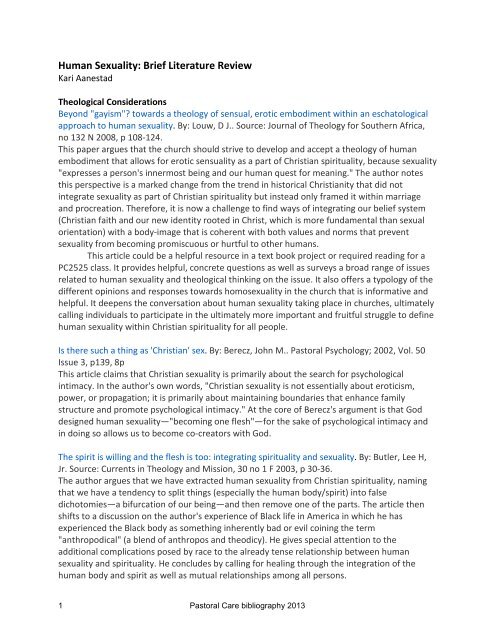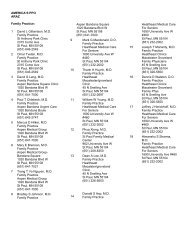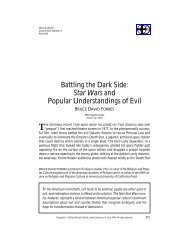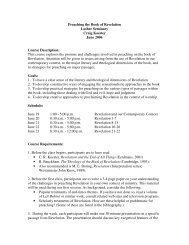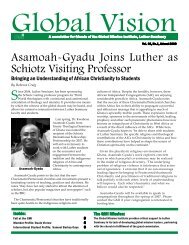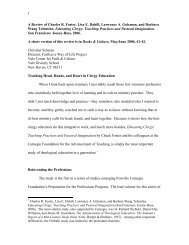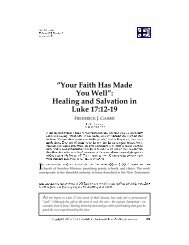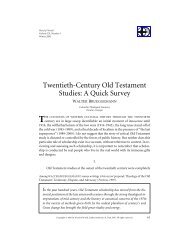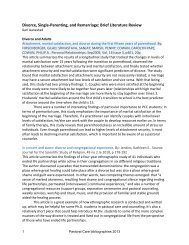Human Sexuality: Brief Literature Review
Human Sexuality: Brief Literature Review
Human Sexuality: Brief Literature Review
Create successful ePaper yourself
Turn your PDF publications into a flip-book with our unique Google optimized e-Paper software.
<strong>Human</strong> <strong>Sexuality</strong>: <strong>Brief</strong> <strong>Literature</strong> <strong>Review</strong>Kari AanestadTheological ConsiderationsBeyond "gayism"? towards a theology of sensual, erotic embodiment within an eschatologicalapproach to human sexuality. By: Louw, D J.. Source: Journal of Theology for Southern Africa,no 132 N 2008, p 108-124.This paper argues that the church should strive to develop and accept a theology of humanembodiment that allows for erotic sensuality as a part of Christian spirituality, because sexuality"expresses a person's innermost being and our human quest for meaning." The author notesthis perspective is a marked change from the trend in historical Christianity that did notintegrate sexuality as part of Christian spirituality but instead only framed it within marriageand procreation. Therefore, it is now a challenge to find ways of integrating our belief system(Christian faith and our new identity rooted in Christ, which is more fundamental than sexualorientation) with a body-image that is coherent with both values and norms that preventsexuality from becoming promiscuous or hurtful to other humans.This article could be a helpful resource in a text book project or required reading for aPC2525 class. It provides helpful, concrete questions as well as surveys a broad range of issuesrelated to human sexuality and theological thinking on the issue. It also offers a typology of thedifferent opinions and responses towards homosexuality in the church that is informative andhelpful. It deepens the conversation about human sexuality taking place in churches, ultimatelycalling individuals to participate in the ultimately more important and fruitful struggle to definehuman sexuality within Christian spirituality for all people.Is there such a thing as 'Christian' sex. By: Berecz, John M.. Pastoral Psychology; 2002, Vol. 50Issue 3, p139, 8pThis article claims that Christian sexuality is primarily about the search for psychologicalintimacy. In the author's own words, "Christian sexuality is not essentially about eroticism,power, or propagation; it is primarily about maintaining boundaries that enhance familystructure and promote psychological intimacy." At the core of Berecz's argument is that Goddesigned human sexuality—"becoming one flesh"—for the sake of psychological intimacy andin doing so allows us to become co-creators with God.The spirit is willing and the flesh is too: integrating spirituality and sexuality. By: Butler, Lee H,Jr. Source: Currents in Theology and Mission, 30 no 1 F 2003, p 30-36.The author argues that we have extracted human sexuality from Christian spirituality, namingthat we have a tendency to split things (especially the human body/spirit) into falsedichotomies—a bifurcation of our being—and then remove one of the parts. The article thenshifts to a discussion on the author's experience of Black life in America in which he hasexperienced the Black body as something inherently bad or evil coining the term"anthropodical" (a blend of anthropos and theodicy). He gives special attention to theadditional complications posed by race to the already tense relationship between humansexuality and spirituality. He concludes by calling for healing through the integration of thehuman body and spirit as well as mutual relationships among all persons.1 Pastoral Care bibliography 2013
Biological/Psychological Considerations<strong>Human</strong> sexual development. By: DeLamater, John; Friedrich, William N.. Journal of SexResearch; 39(1), 10-14; 2002, 5pThis article is a quick yet incredibly helpful piece that aptly outlines and summarizes the basicstages of human sexual development. It notes that human sexual development is a process thatbegins at conception and ends at death, emphasizing the longevity and complexity of anongoing process. It covers everything from the quality of attachment relationship to parentamong children 0-7 years old, to adolescents' struggle with identity and role confusion tomenopause and andropause. I think this article would be an incredibly helpful overview ofhuman sexual development for any student curious about the very basic biological factors.Biological factors in human sexuality. By: Bancroft, John. Journal of Sex Research; Feb 2002, Vol.39 Issue 1, p15, 7pThis paper provides a more developed overview of some key terms and issues relevant to thestudy of human sexual development (such as the effect of hormones on sexuality, humansexual development, menopause and andropause, etc.) and concludes with a consideration ofhow very little is known about the relationship between biology and culture and the influenceof their interaction in shaping human sexuality. Bancroft notes that while gender identityusually develops in a way that is consistent with genetic status, that is not always the caseindicating that there is a degree of plasticity in the process, which could be an interesting pointin any discussion on human sexual/gender identity and possible theological implications.<strong>Sexuality</strong> and attachment from a clinical point of view. By: Laschinger, Bernice; Purnell, Chris;Schwartz, Joseph; White, Kate; Wingfield, Rachel. Attachment & <strong>Human</strong> Development;Jun2004, Vol. 6 Issue 2, p151, 14pThis article is heavy on psychotherapy/analysis and clinical experience and lighter on theologybut still provides interesting and helpful information on attachment theory and humansexuality. The authors, drawing on their own clinical experience, conclude that human sexualityis a strong reflection of early attachment histories. Critiquing previous research on humansexuality as being too focused on physical/genital dimensions, the authors argue that thepsychological dimension of human sexuality cannot be separated from the psychologicaldimensions of attachment. The article concludes with a case study that exemplifies thecomplexity and issues around the relationship between human sexuality and attachment.Identity in Crisis: Spirituality and Homosexuality in Adolescence. By: Cates, James. Child &Adolescent Social Work Journal; Aug2007, Vol. 24 Issue 4, p369, 15pThis article points out that the treatment of homosexual practices is an issue that is presentlypolarizing the mental health community, and adding the treatment of adolescents intoconsideration makes the issue even further complicated. The author, drawing on his ownclinical work with adolescent males struggling with their Christian faith and possiblyhomosexual identity, argues that it's important for mental healthcare providers to find ways ofsupporting clients' autonomy in making decisions in their lives as well as living out genuine2 Pastoral Care bibliography 2013
exploration of sexual identity. Three case studies from the author’s practice as a clinicalpsychologist are discussed.Genders and sexualities in individuation: theoretical and clinical explorations. By: McKenzie,Susan. Journal of Analytical Psychology; Feb2010, Vol. 55 Issue 1, p91, 21pThis article delves into a more recent exploration among researchers in the psychology ofgender formation in relationship to biological sex, culture, brain development, and attachmentexperiences—or the role of sexuality in the formation of gender identity. The author exploresthe emergence of same-sex desire at mid-life, drawing on evidence from two case studieswhere she uses dream analysis as a window into the emergence of gender identity. The authorconsiders the impact of sexual desire on gender identities through the lenses of culture,dynamic systems theory, neuroscience, and depth psychology.Social ConsiderationsToward Same-Sex Unions and the Perceived Cause of Homosexuality. By: Whitehead, AndrewL.. Social Science Quarterly (Blackwell Publishing Limited); Mar2010, Vol. 91 Issue 1, p63, 17p, 4ChartsThis study uses the Baylor Religion Survey (2007) to estimate the effects of religion and beliefson attitudes toward same-sex unions. The study finds that religion is strongly associated withthe belief that homosexuals choose their sexual orientation and that religion maintains asignificant association with attitudes toward same-sex unions. The article concludes that even ifa biological explanation for homosexuality is ultimately proven, unfavorable attitudes towardsame-sex unions will most likely persevere because of religion’s persistent effect.Beyond the nuclear family? Familism and gender ideology in diverse religious communities. By:Edgell, Penny; Docka, Danielle. Sociological Forum; 2007, Vol. 22 Issue 1, p25, 26pThis article examines three church case studies in light of previous research by Smith (1993) andothers on religious familism, or the influence of local religious communities in normativelydefining what good or healthy family as well as gender roles and identity. Smith influentiallyargued that religious communities have played a key role in defining the Standard NorthAmerican Family (SNAF), which is comprised of two heterosexual married adults with children.This article, however, provides a challenge to Smith and SNAF by naming that much of previousresearch has limited its scope to white middle class communities. By contrast, this articleexamines three churches who are self-described as having "innovative approaches tofamily/family ministry" and are predominantly white, Latino, and African-Americanrespectively. The article finds that the three churches each have innovative family-orientedlanguage and ministry with a range of gendered practices, all of which support more inclusiveunderstandings of families than the other religious communities in previous research.3 Pastoral Care bibliography 2013


